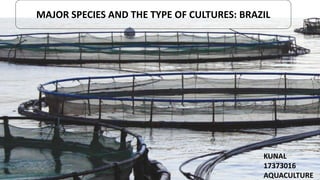
Major species and types of cultures brazil
- 1. MAJOR SPECIES AND THE TYPE OF CULTURES: BRAZIL KUNAL 17373016 AQUACULTURE
- 2. Largest country in South America. Fifth Largest Country by Area. Coastline of 7,491km. Divided in 26 states, a Federal District, and 5,561 municipalities & the states are grouped in five regions. BRAZIL
- 3. Species Culture Mollusc Seaweed Crustaceans Freshwater FISh Turtles Marine fishOther Valuable species
- 4. 1. Freshwater fishes: Tilipia- Nile tilapia (Oreochromis niloticus); Carp-Common carp (Cyprinus carpio ) including Bighead carp (Aristichthys nobilis ), Silver carp (Hypophthalmichthys molitrix ) & Grass carp (Ctenopharyngodon idellus ); Round fishes- ‘Pacu' (Piaractus mesopotamicus ), ‘Tambaqui' (Colossoma macropomum ), their hybrid ‘Tambacu' and the native catfish called ‘Turubim' or ‘Cachara' (Pseudoplatystoma fasciatum ) and ‘Pintado' (Pseudoplatystoma coruscans ) 2. Marine fish: ‘Arabaiana' (Seriola Ialandi ), ‘Carapeba' (Diapterus rhombeus ),Grouper (Epinephelus spp) & Snook (Centropomus spp). 3. Native species: ‘Pirarucu' (Arapaima gigas ), ‘Matrinxã' (Brycon cephalus ) and ‘Piracanjuba' (Brycon orbignyanus ). 4. Mollusc: Mussels (Perna perna ),Oysters (Crassostrea gigas and C.rhizophorae ) and Scallops (Lyropecten nodosus ). S P E C I E S C U L T U R E
- 5. 8. Other valuable species: Common snook (Centropomus undecimalis ), the flounder (Paralichthys spp), the pompano (Trachinotus carolinus ) and the Peixe-rei (Odontesthes bonariensis ). 7.Turtles: Podocnemis expansa and P. unifilis. 5. Seaweed: Porphyra spp and Gracilaria spp. 6. Crustaceans: Whiteleg shrimp (Penaeus vannamei ), Giant river prawn (Macrobrachium rosenbergii ), Exotic species Litopenaeus vanammei , Native species Penaeus paulensis. S P E C I E S C U L T U R E
- 7. Tilapias are the second-most important cultured finfish worldwide (next to the cyprinids). Nile tilapia (Oreochromis niloticus) ranks 6th among the most important cultured species, providing food, jobs and domestic and export earnings. The top 10 tilapia producers for 2015 are: 1.People’s Republic of China (1.8 million tonnes), 2.Indonesia (1.1 million tonnes), 3.Egypt (875 thousand tonnes), 4.Bangladesh (324 thousand tonnes), 5.Vietnam (283 thousand tonnes), 6.Philippines (261 thousand tonnes), 7.Brazil (219 thousand tonnes), 8.Thailand (177 thousand tonnes), 9.Colombia (61 thousand tonnes), and 10.Uganda (57 thousand tonnes). TILAPIA
- 8. 1.RACEWAYS CULTURE 2.POND CULTURE 3. RICE-FISH CULTURE 5.LONGLINES CULTURE 4.POLYCULTURE 6.RAFT CULTURE 7.WATER RECIRCULATION TANK
- 9. Northern region Northeastern region Mid-Western region Southeastern region Southern region MIDWEST NORTHEAST NORTH SOUTHEAST SOUTH Tilapia 30.8 82.9 11.1 88 88 Round Fishes 46.2 17.1 72.2 10 0 Catfish 19.2 0 5.6 0 4 Carp 0 0 5.6 0 4 Other Species 3.8 0 5.6 2 0 AQUACULTURE BY REGION OF BRAZIL (%):
- 10. More than 2,000 fish species including almost all the freshwater fish, 75% of all Brazilian freshwater species and 30% of the world’s fish fauna. Extensive and semi-intensive systems in excavated ponds or small impoundment semi-natural lakes. Excellent location for aquaculture. Ornamental fish: Cardinal (Paracheirodon axelrodi), Discus (Symphysodon discus) & coridoras (Corydoras sp.). Four groups of aquatic animals are : 1.The freshwater fish, with 17 species, three being exotics. The main species are the tambaqui, curimatã (Prochilodus nigricans) & pirarucu (Arapaima gigas). Exotic species cultured in the region are C. carpio, Oreochromis niloticus and Tilapia sp. 2. Crustaceans (L. vannamei, Macrobrachium amazonicum, M. rosenbergii). 3. Amphibians (Rana catesbeiana). 4. The Amazonian turtle (Podocnemis expansa). NORTHERN REGION
- 11. NORTHEASTERN REGION All kinds of culture systems. 1.Partial or total water recirculation 2. Feeding trays 3. Polyculture 4. Floating cage 5. Raceway Tank In extensive systems,farmers stock juvenile tambaqui, curimatas (Prochilodus argenteus and P. brevis), tilapia and carp (common and Chinese) in reservoirs. Semi-intensive culture is conducted in earthen ponds that are stocked with tilapia (Figure 5), tambaqui, freshwater shrimp (M. rosenbergii) and marine shrimp (primarily L. vannamei). Polyculture with the indigenous mangrove oyster (C. rhizophorae) and macroalgae (Graillaria sp.), as a natural filter of suspended particles and nutrients in the drainage canals to improve the quality of the effluent water.
- 12. MIDWESTERN REGION Favorable for aquaculture. Culture of finfishes (scaled and catfishes), mostly of native species pacu (P. mesopotamicus), surubim pintado (P. coruscans), surubim cachara (P. fasciatum), piracanjuba (Brycon orbignianus), piraputanga (Brycon hilarii), piauçu (Leporinus obtusidens), bullfrog (R. catesbeiana), Amazonian turtle (P. expansa), tracajá turtle (P. unifilis) and alligator (Caiman crocodiles yacare).
- 13. SOUTHEASTERN REGION Farming of coldwater fish species in the mountains, warm freshwater fish and crustaceans on the plains and molluscs along the coast. Reared in semi-intensive and intensive systems. Several different species - both indigenous and non-indigenous. 1.Indigenous species: Pacu and Tambaqui, Surubim. 2.Non-indigenous species: Common carp, Tilapia (In Cages). Native carnivores species, such as surubim, surubim cachara (P. fasciatum) and dourado (Salminus maxillosus). Rainbow trout (Oncorhynchus mykiss). Culture of the Japanese oyster (C. gigas) and native mussel (P. perna), C. gigas and scallops (Nodipecten nodosus). Indigenous mangrove oyster (C. rhizophorae). Crustacean culture is mainly represented by the freshwater prawn (M. rosenbergii). White shrimp (Litopenaeus vannamei). Bullfrog (R. catesbeiana).
- 14. SOUTHERN REGION Sub-tropical climate. Aquaculture in Southern Brazil can be broadly characterized as a small household affair. It can be divided into two main lines of production: 1. Polyculture of carp (C. carpio, A. nobilis, H. molitrix and C. idella). 2. Semi-intensive culture of tilapia (around 80 percent O. niloticus). Rainbow trout (O. mykiss) in Mountain areas. Native fish species- jundiá (Rhamdia quelen). Native mussel (P. perna), Japanese oyster (C. gigas), C. rhizophorae and scallop N. nodosus. Flounder (Paralichthys orbignyanus) and snook (Centropomus parallelus and C. undecimallis).
- 18. REFERENCES Roubach R., Correia Udes S., Zaiden.S., Martino Ricardo C., and Cavalli Ronaldo O.,2017. Aquaculture in Brazil. The FAO Yearbook of fishery and aquaculture statistics,2016. FAO: Fishery and Aquaculture Country Profiles: The Federative Republic of Brazil,2018. Valenti W.C., 2007.Brazil's inland aquaculture. Freshwater fish dominate production.
- 19. THANK YOU